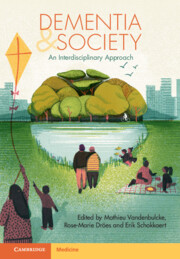Book contents
- Dementia and Society
- Dementia and Society
- Copyright page
- Contents
- Contributors
- Additional material
- Preface
- Chapter 1 Different Perspectives on Dementia
- Chapter 2 From History to Intervention
- Chapter 3 Personhood, Identity and Autonomy
- Chapter 4 Living Meaningfully with Dementia
- Chapter 5 Quality of Life of Persons with Dementia
- Chapter 6 Living with Dementia
- Chapter 7 Informal Care for Persons with Dementia
- Chapter 8 Risk Factors and Non-Pharmacological Prevention of Dementia
- Chapter 9 An Empowering Dementia Environment
- Chapter 10 The Impact of the COVID-19 Pandemic on the Well-Being of People Living with Dementia
- Chapter 11 Care Planning and the Lived Experience of Dementia
- Chapter 12 Societal and Ethical Views on End-of-Life Decisions in Dementia
- Chapter 13 Driving and Dementia
- Chapter 14 Social and Private Costs of Dementia
- Index
- References
Chapter 8 - Risk Factors and Non-Pharmacological Prevention of Dementia
Published online by Cambridge University Press: 26 May 2022
- Dementia and Society
- Dementia and Society
- Copyright page
- Contents
- Contributors
- Additional material
- Preface
- Chapter 1 Different Perspectives on Dementia
- Chapter 2 From History to Intervention
- Chapter 3 Personhood, Identity and Autonomy
- Chapter 4 Living Meaningfully with Dementia
- Chapter 5 Quality of Life of Persons with Dementia
- Chapter 6 Living with Dementia
- Chapter 7 Informal Care for Persons with Dementia
- Chapter 8 Risk Factors and Non-Pharmacological Prevention of Dementia
- Chapter 9 An Empowering Dementia Environment
- Chapter 10 The Impact of the COVID-19 Pandemic on the Well-Being of People Living with Dementia
- Chapter 11 Care Planning and the Lived Experience of Dementia
- Chapter 12 Societal and Ethical Views on End-of-Life Decisions in Dementia
- Chapter 13 Driving and Dementia
- Chapter 14 Social and Private Costs of Dementia
- Index
- References
Summary
A life-course approach to enhance tolerance to and prevent dementia and senescence is increasingly embraced by scientists, clinicians and policy makers to promote healthy ageing. Tolerance enhancement and prevention remain the most sensible courses of action given the lack of effective dementia treatment. We discuss the modifiable risk factors of dementia, and address social isolation and loneliness in view of their importance from a psychological and societal perspective. The effectiveness of prevention strategies and non-pharmacological intervention is increasingly supported by scientific evidence. They support an actionable model of dementia and senescence prevention that is cost effective and converges with established public health programmes (diet, exercise, mental health). They also relate to central societal issues (social inequality, pollution, healthcare), and translate to multidisciplinary professional interventions that are tailored to the individual. Changing lifestyle might be an effective way to address the challenges of dementia and senescence in our ageing populations, but also represents one of the most formidable psychosocial and societal challenges.
Keywords
- Type
- Chapter
- Information
- Dementia and Society , pp. 153 - 166Publisher: Cambridge University PressPrint publication year: 2022



